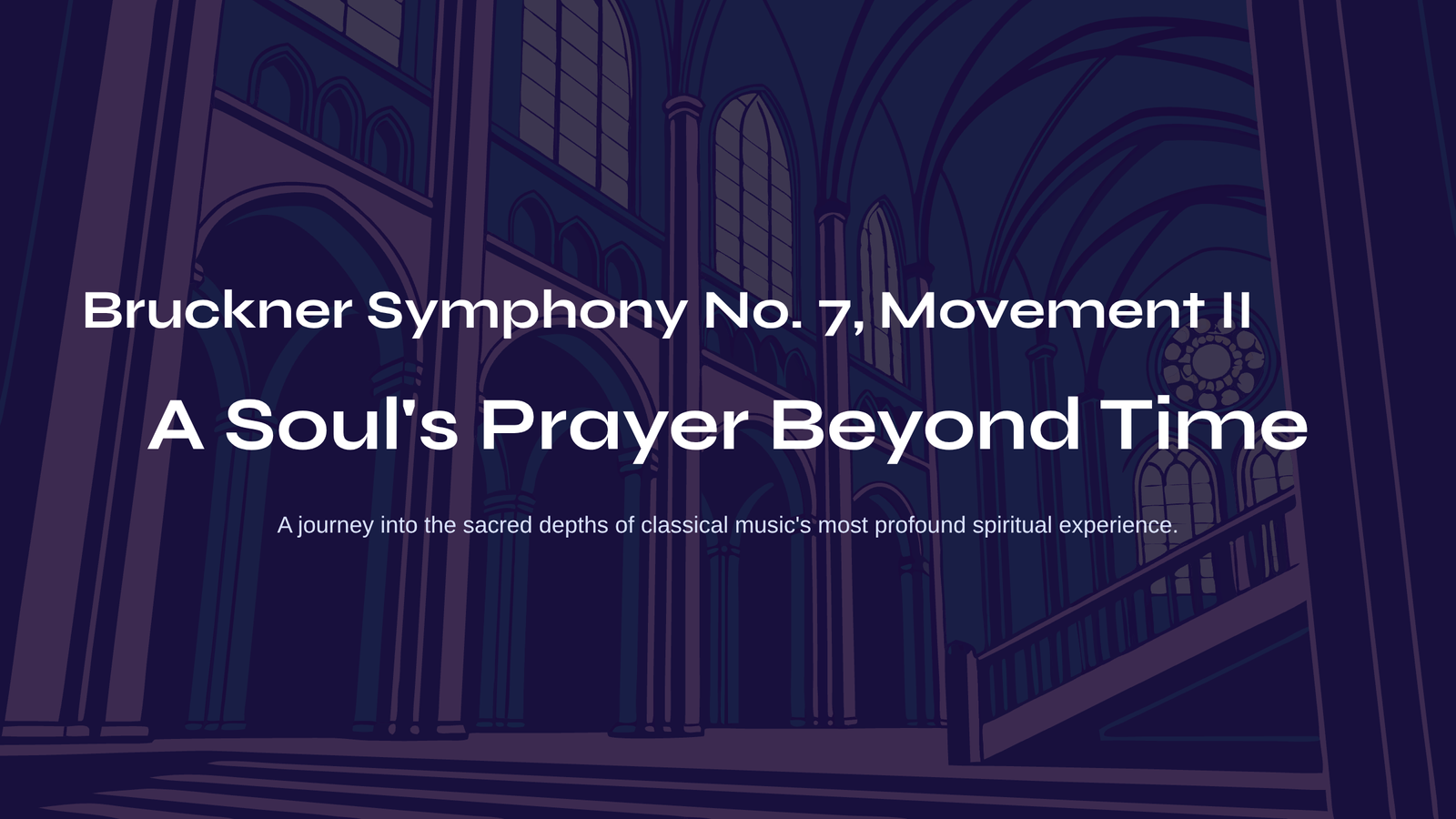Table of Contents
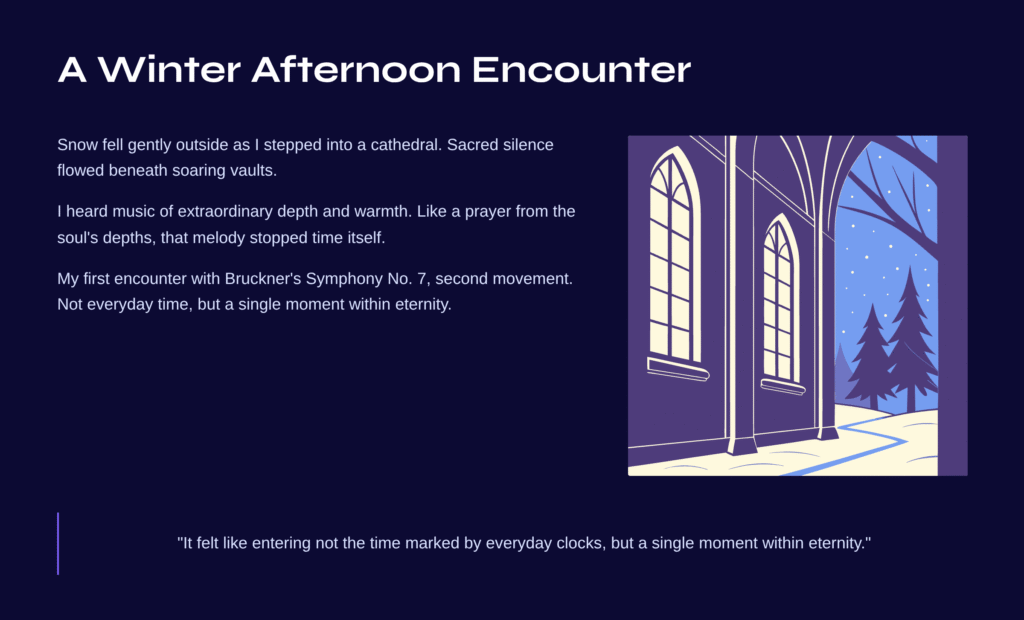
A Winter Afternoon Encounter in the Cathedral
On a winter afternoon when snow was gently falling outside, I happened to step into a cathedral. In that sacred space where silence flowed beneath soaring vaults, I heard music of extraordinary depth and warmth. Like a prayer emanating from the depths of the soul, that melody possessed the power to stop time itself.
That was my first encounter with the second movement of Bruckner’s Symphony No. 7. It felt like entering not the time marked by everyday clocks, but a single moment within eternity.
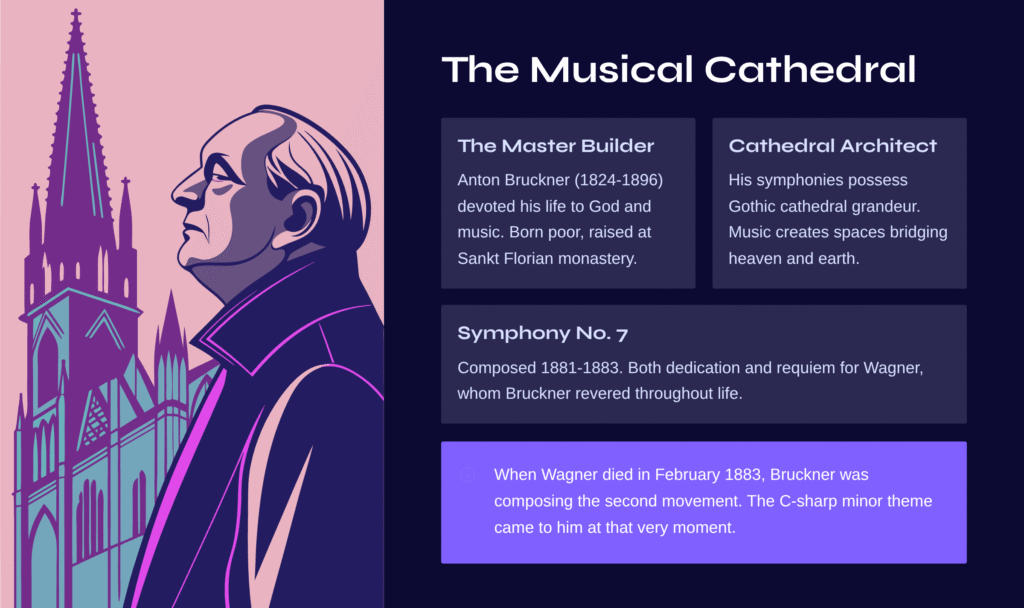
The Musical Cathedral Left by a Master Builder
The Unique Nature of Bruckner as a Composer
To understand Anton Bruckner (1824-1896), you must first recognize the two things to which he devoted his entire life: a profound faith in God and a pure passion for music. Born into a poor rural teacher’s family in Austria, he lost his father at thirteen and was raised at the monastery of Sankt Florian. His experience there as an organist became the spiritual foundation that would permeate his entire musical output.
People call Bruckner the “cathedral architect.” His symphonies possess the grandeur and sacred structure of vast Gothic cathedrals. Rather than simply creating beautiful melodies, he was a composer who used music to create spaces that bridge heaven and earth.
The Special Meaning of Symphony No. 7
Composed between 1881 and 1883, Symphony No. 7 holds particular significance for Bruckner. This work serves as both a dedication and a requiem for Richard Wagner, whom Bruckner revered throughout his life. Bruckner was such a devoted Wagner enthusiast that he would wait for hours outside Wagner’s house, hoping for just a glimpse of his idol.
In February 1883, when Wagner passed away in Venice, Bruckner was composing the second movement. In a letter, he confessed: “I was very sad. The thought came to me that the master would soon die, and at that very moment the C-sharp minor theme of the Adagio came into my mind.”
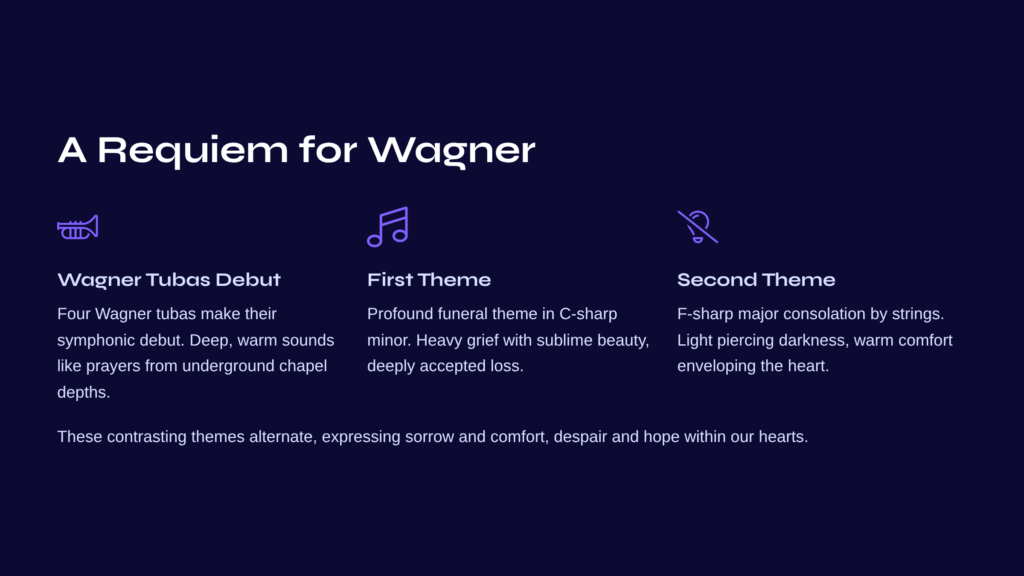
A Requiem for Wagner – The World of the Second Movement Adagio
The Mystical Entrance of the Wagner Tubas
The most remarkable aspect of this movement is the debut appearance of four Wagner tubas in symphonic repertoire. These instruments, specially designed by Wagner for his Ring cycle, were employed by Bruckner as a tribute to his master.
The Wagner tubas occupy the range between horns and trombones, creating a uniquely mysterious timbre. The deep, warm sounds these instruments produce are like prayers echoing from the depths of an underground chapel. Unlike conventional brass instruments, they possess a resonance that seems to caress the soul directly.
Two Themes Painting an Emotional Journey
This Adagio, beginning in C-sharp minor, unfolds around two contrasting themes.
The first theme is a profound and solemn funeral theme played by the Wagner tubas. It evokes the feeling of heavy grief pressing upon the heart. Yet this sorrow is not despairing. Rather, it contains a deeply accepted sense of loss, within which blooms a sublime beauty.
The second theme modulates to F-sharp major and is played by the strings. Escaping from the weight of the first theme, it delivers a message of consolation and hope. Like a shaft of light piercing the darkness, warm comfort envelops the heart.
These two themes appear alternately while gradually developing and transforming. They express the interplay of sorrow and comfort, despair and hope that occurs within our hearts.
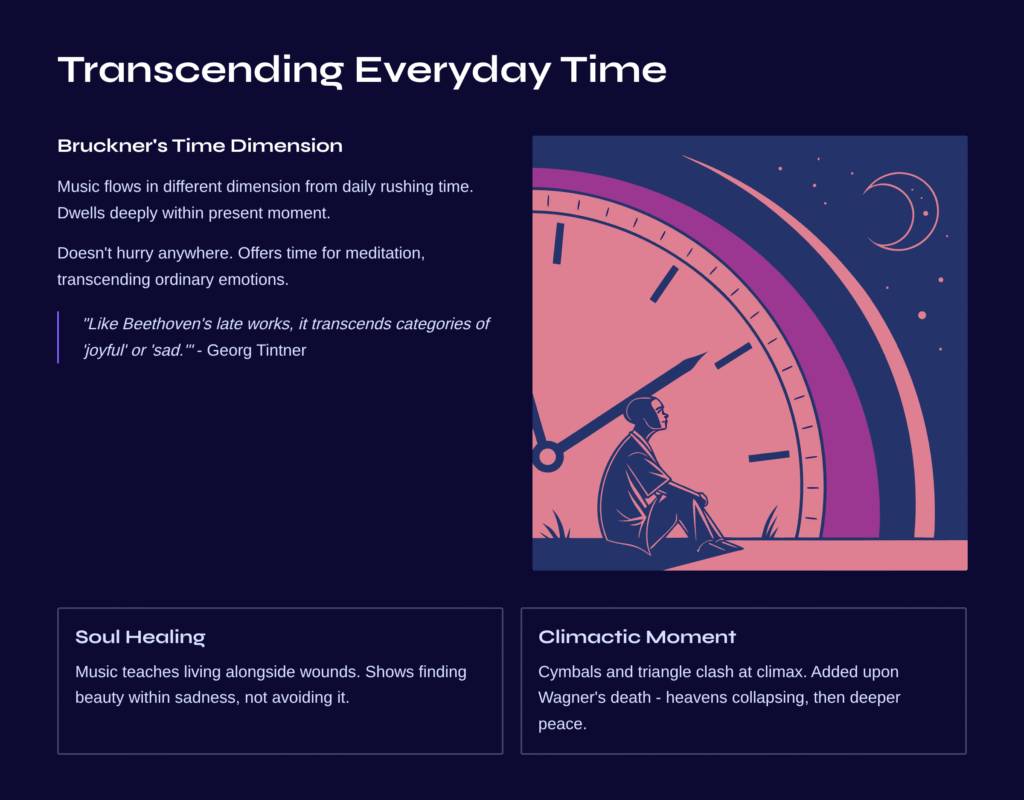
My Experience of Bruckner’s Time
Transcending the Everyday
When I first heard Bruckner’s music, what puzzled me most was the “sense of time.” It flowed in a completely different dimension from the time we experience daily – time rushing toward destinations. This music doesn’t hurry anywhere. It dwells deeply within the present moment, offering a time for meditation.
Musicologist Georg Tintner spoke of one of Bruckner’s melodies this way: “If I had to explain what makes Bruckner Brucknerian, it would be exactly that melody. It is something that transcends ordinary kinds of emotions. You can’t even ask whether it’s ‘joyful’ or ‘sad.’ Like Beethoven’s late works, it transcends such categories.”
Music That Heals the Soul
Through repeated listening to this movement, I realized something profound. This music doesn’t simply cover our wounds but teaches us how to live alongside them. Rather than pushing away or avoiding sadness, it shows us how to find beauty even within that sadness.
The clash of cymbals and triangle at the climax provides an unforgettable experience. Legend has it that Bruckner added this collision upon hearing of Wagner’s death. The sound delivers a shock like the heavens collapsing, yet the music that follows leads us to even deeper peace.
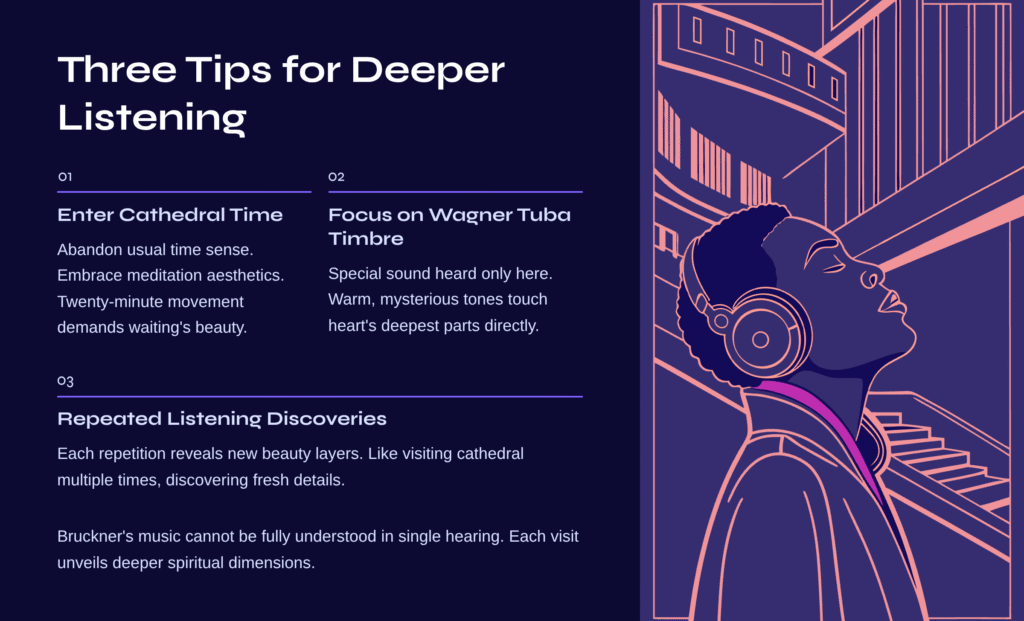
Three Tips for Deeper Listening
1. Enter Cathedral Time
When appreciating Bruckner’s music, completely abandon your usual sense of time. This music demands a temporality far removed from efficiency or productivity. Like meditation, surrender yourself to the flow of the music. To fully experience this long movement of over twenty minutes, you must embrace the aesthetics of waiting.
2. Focus on the Wagner Tuba Timbre
Don’t miss the special sound of the Wagner tubas, heard only in this movement. Feel how these warm yet mysterious tones, unlike conventional brass instruments, touch the deepest parts of our hearts. Like prayer voices echoing from an underground cathedral, the resonance of these instruments directly caresses the soul.
3. New Discoveries Through Repeated Listening
Bruckner’s music cannot be fully understood in a single hearing. Each repetition reveals new layers of beauty. In your first listening, absorb the overall atmosphere; in the second, focus on the main melodies; in the third, sense the subtle harmonic changes. It’s like visiting a cathedral multiple times and discovering new details with each visit.
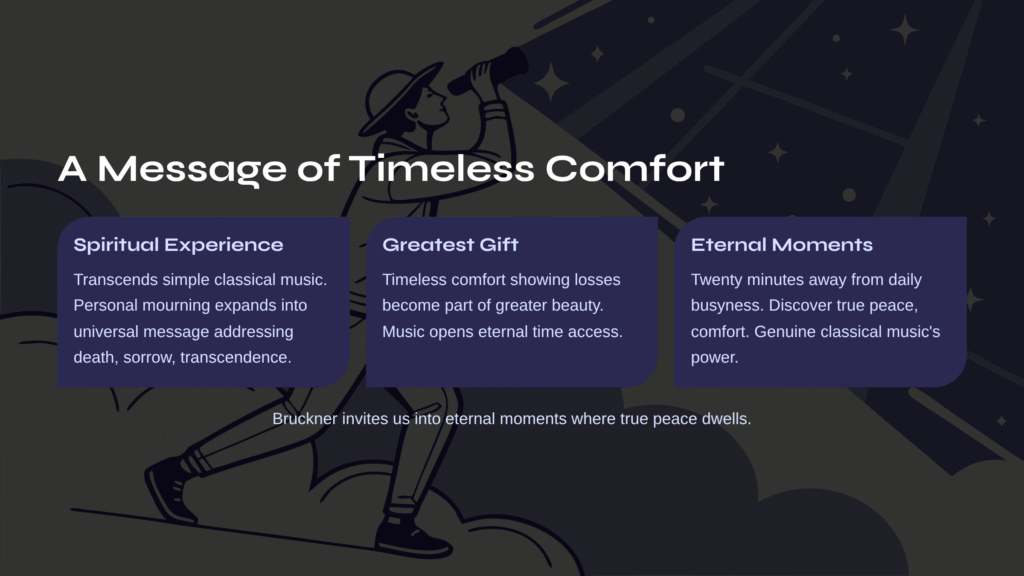
A Message of Timeless Comfort
The second movement of Bruckner’s Symphony No. 7 transcends simple classical music to become a spiritual experience. Beginning with personal mourning for Wagner, it ultimately expands into a universal message addressing fundamental human concerns: death, sorrow, comfort, and transcendence.
The greatest gift this music offers is “timeless comfort.” It shows us that all the losses and sorrows we experience can ultimately become part of a greater beauty, and that through music we can enter into eternal time.
For over twenty minutes, Bruckner invites us away from daily busyness into “eternal moments.” There we can discover true peace and comfort. This is the power of genuine classical music and the most precious gift Bruckner left us.
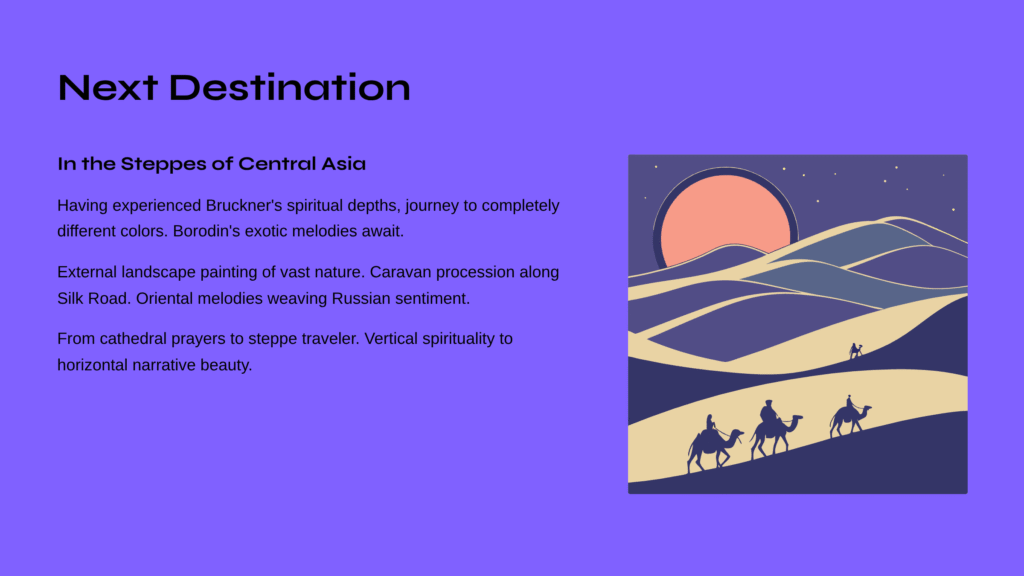
Next Destination: In the Steppes of Central Asia with Borodin
Having experienced Bruckner’s profound spiritual world, how about journeying to music of completely different colors? Alexander Borodin’s “In the Steppes of Central Asia” offers an external landscape painting of vast nature and exotic melodies, contrasting with Bruckner’s internal meditation.
This work by Borodin, one of the Russian Five, delivers the vividness of watching a caravan procession unfold along the Silk Road. The sonic panorama created by the interweaving of Oriental melodies and Russian sentiment shows us the beauty of horizontal narrative, different from Bruckner’s vertical spirituality.
Having finished prayers in the cathedral, why not now become a traveler racing across vast steppes, departing into Borodin’s exotic melodies?
